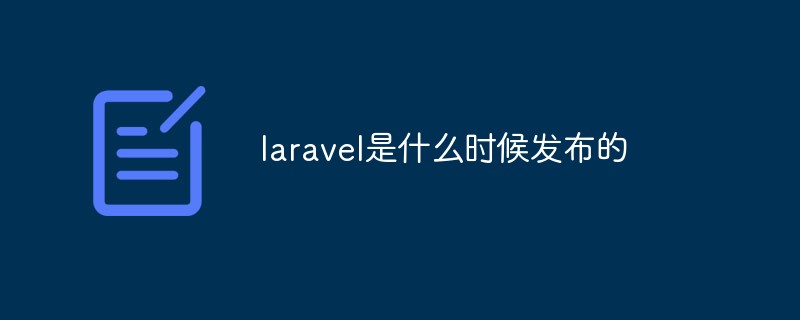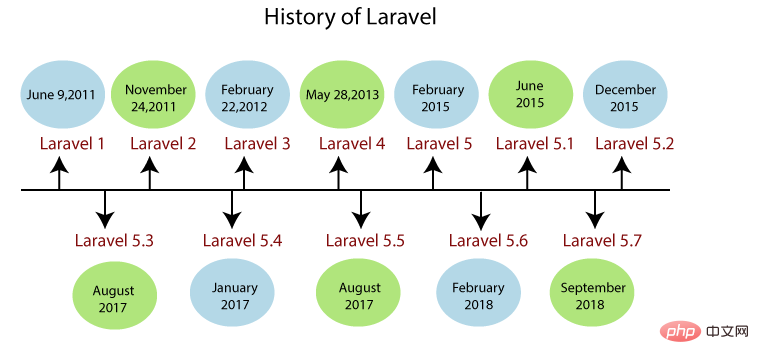When was laravel released?
Laravel was the first Beta version released on June 9, 2011, and laravel1 was released within a month; laravel1 was released with some built-in modules, such as verification methods, paging, and command line packages Programming and Eloquent ORM; later Laravel2 was released on November 24, 2011, laravel3 was released on February 22, 2012, followed by laravel9 in February 2022.

#The operating environment of this article: Windows 10 system, Laravel version 9, Dell G3 computer.
When was laravel released

Laravel1
The first Beta version of Laravel was in 2011 Released on June 9, Laravel 1 was released within a month after releasing the beta version. Laravel 1 comes with some built-in features such as authentication, Eloquent ORM for database operations, localization, models and relationships, simple routing mechanism, caching, sessions, views, extensibility through modules and libraries, and HTML helpers.
Laravel 1 does not follow the MVC framework, but developers use this framework because its syntax is very clear. After Laravel 1 development, Taylor Otwell added new features such as validation methods, pagination, command line package installer, and Eloquent ORM. Due to the addition of new features, a new version was developed, Laravel 2, and it took less than six months to develop.
Laravel2
Laravel 2 version was released on November 24, 2011. Laravel2 eliminates the issues raised in Laravel 1, Laravel 2 follows MVC architecture. Laravel 2 can be considered a true MVC framework. In September 2011, Laravel 2 was released with built-in support for controllers, template engines (called Blades), and Inversion of Control (IOC). Thanks to the addition of controllers, the Laravel 2 framework becomes a fully qualified MVC framework. The main disadvantage of this framework is that it eliminates support for third-party modules.
Laravel3
Laravel 3 version was released on February 22, 2012. This version includes essential features such as unit test integration, Artisan command line interface, database migration, events, session driver, database driver, and more. Laravel 3 is the most stable and simple framework for use in various web applications. Laravel 3 entered the market as a stable version and many developers started switching to the Laravel framework. Five months after the release of Laravel 3, the creators of the framework started working on creating a new version of the framework, namely Laravel 4.
Laravel4
The Laravel version was released on May 28, 2013, one year and three months after version 3 was released. Although releasing new versions is a sign of the framework's continued evolution, it reduces the framework's credibility. Developers demand stability and hence Laravel 4 enters the market to achieve a bright future in PHP development.
Laravel 4 was written from the ground up as a collection of components that integrate with each other. Management of these components is done through a dependency manager called Composer. Laravel 4 comes with an expanded feature set that other versions of Laravel don’t need to provide, such as database seeds, message queues, built-in mailer, Eloquent ORM with scopes, soft deletes, etc.
Laravel5
Laravel 5 version was released in February 2015 and is an enhancement to the previous version Laravel 4. New in Laravel 5 is the ability to regularly schedule tasks for execution through a package called Scheduler, an abstraction layer called Flysystem that allows the use of remote storage. As with the local file system Elixir, authentication is simplified by using the Socialite package. It also introduces a new feature, directory tree structure for developed applications.
Laravel 5.1 was released in June 2015. It includes new features such as a new directory structure, simplified method injection, and the concept of route caching.
Laravel 5.2 was released in December 2015, and features added in this version include authentication scaffolding, array validation, server monitoring, and Laravel Cashier.
Laravel 5.3 was released in August 2016. It includes features like Laravelecho, new notification system, Laravel Scout and Passport.
Laravel 5.4 was released in January 2017. It includes features like Laravel Dusk, Laravel Mix, Automatic Facades and improved routing.
Laravel 5.5 version was released in August 2017. This release introduces PHP 7 to enhance the performance of Laravel applications. It also includes new features such as Route methods and automatic package discovery to add packages automatically.
Laravel 5.6 version was released in February 2018. It contains new features such as new blade instructions and API controller generation. New features such as Argon and password hashing support have also been added in this release. Bootstrap 4 was released before Laravel 5.6, so Bootstrap 4 was introduced in this version.
Laravel 5.7 version was released in September 2018, which includes features such as Laravel Dump Server and Laravel Nova. Some other features have been added in this release, such as URL Generator and Callable Syntax, as well as improved error messages.
[Related recommendations: laravel video tutorial]
The above is the detailed content of When was laravel released?. For more information, please follow other related articles on the PHP Chinese website!

Hot AI Tools

Undresser.AI Undress
AI-powered app for creating realistic nude photos

AI Clothes Remover
Online AI tool for removing clothes from photos.

Undress AI Tool
Undress images for free

Clothoff.io
AI clothes remover

Video Face Swap
Swap faces in any video effortlessly with our completely free AI face swap tool!

Hot Article

Hot Tools

Notepad++7.3.1
Easy-to-use and free code editor

SublimeText3 Chinese version
Chinese version, very easy to use

Zend Studio 13.0.1
Powerful PHP integrated development environment

Dreamweaver CS6
Visual web development tools

SublimeText3 Mac version
God-level code editing software (SublimeText3)

Hot Topics
 1664
1664
 14
14
 1423
1423
 52
52
 1319
1319
 25
25
 1269
1269
 29
29
 1249
1249
 24
24
 Laravel Introduction Example
Apr 18, 2025 pm 12:45 PM
Laravel Introduction Example
Apr 18, 2025 pm 12:45 PM
Laravel is a PHP framework for easy building of web applications. It provides a range of powerful features including: Installation: Install the Laravel CLI globally with Composer and create applications in the project directory. Routing: Define the relationship between the URL and the handler in routes/web.php. View: Create a view in resources/views to render the application's interface. Database Integration: Provides out-of-the-box integration with databases such as MySQL and uses migration to create and modify tables. Model and Controller: The model represents the database entity and the controller processes HTTP requests.
 Solve caching issues in Craft CMS: Using wiejeben/craft-laravel-mix plug-in
Apr 18, 2025 am 09:24 AM
Solve caching issues in Craft CMS: Using wiejeben/craft-laravel-mix plug-in
Apr 18, 2025 am 09:24 AM
When developing websites using CraftCMS, you often encounter resource file caching problems, especially when you frequently update CSS and JavaScript files, old versions of files may still be cached by the browser, causing users to not see the latest changes in time. This problem not only affects the user experience, but also increases the difficulty of development and debugging. Recently, I encountered similar troubles in my project, and after some exploration, I found the plugin wiejeben/craft-laravel-mix, which perfectly solved my caching problem.
 How to learn Laravel How to learn Laravel for free
Apr 18, 2025 pm 12:51 PM
How to learn Laravel How to learn Laravel for free
Apr 18, 2025 pm 12:51 PM
Want to learn the Laravel framework, but suffer from no resources or economic pressure? This article provides you with free learning of Laravel, teaching you how to use resources such as online platforms, documents and community forums to lay a solid foundation for your PHP development journey from getting started to master.
 Laravel user login function
Apr 18, 2025 pm 12:48 PM
Laravel user login function
Apr 18, 2025 pm 12:48 PM
Laravel provides a comprehensive Auth framework for implementing user login functions, including: Defining user models (Eloquent model), creating login forms (Blade template engine), writing login controllers (inheriting Auth\LoginController), verifying login requests (Auth::attempt) Redirecting after login is successful (redirect) considering security factors: hash passwords, anti-CSRF protection, rate limiting and security headers. In addition, the Auth framework also provides functions such as resetting passwords, registering and verifying emails. For details, please refer to the Laravel documentation: https://laravel.com/doc
 Laravel framework installation method
Apr 18, 2025 pm 12:54 PM
Laravel framework installation method
Apr 18, 2025 pm 12:54 PM
Article summary: This article provides detailed step-by-step instructions to guide readers on how to easily install the Laravel framework. Laravel is a powerful PHP framework that speeds up the development process of web applications. This tutorial covers the installation process from system requirements to configuring databases and setting up routing. By following these steps, readers can quickly and efficiently lay a solid foundation for their Laravel project.
 How to view the version number of laravel? How to view the version number of laravel
Apr 18, 2025 pm 01:00 PM
How to view the version number of laravel? How to view the version number of laravel
Apr 18, 2025 pm 01:00 PM
The Laravel framework has built-in methods to easily view its version number to meet the different needs of developers. This article will explore these methods, including using the Composer command line tool, accessing .env files, or obtaining version information through PHP code. These methods are essential for maintaining and managing versioning of Laravel applications.
 What versions of laravel are there? How to choose the version of laravel for beginners
Apr 18, 2025 pm 01:03 PM
What versions of laravel are there? How to choose the version of laravel for beginners
Apr 18, 2025 pm 01:03 PM
In the Laravel framework version selection guide for beginners, this article dives into the version differences of Laravel, designed to assist beginners in making informed choices among many versions. We will focus on the key features of each release, compare their pros and cons, and provide useful advice to help beginners choose the most suitable version of Laravel based on their skill level and project requirements. For beginners, choosing a suitable version of Laravel is crucial because it can significantly impact their learning curve and overall development experience.
 The difference between laravel and thinkphp
Apr 18, 2025 pm 01:09 PM
The difference between laravel and thinkphp
Apr 18, 2025 pm 01:09 PM
Laravel and ThinkPHP are both popular PHP frameworks and have their own advantages and disadvantages in development. This article will compare the two in depth, highlighting their architecture, features, and performance differences to help developers make informed choices based on their specific project needs.




